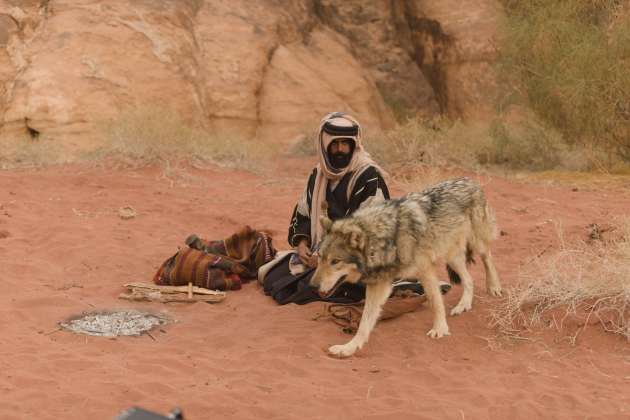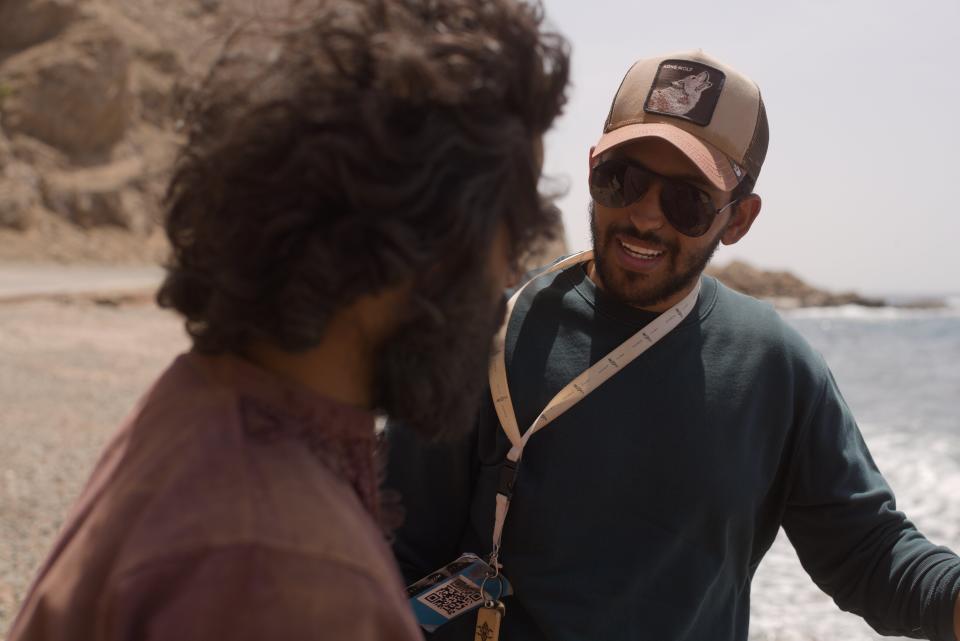Director Moe Alatawi on Why the Saudi Release of Desert Epic ‘Within Sand’ Marks Several Milestones (EXCLUSIVE)

When young Saudi Arabian director Moe Alatawi was growing up, cinema was banned in his country. This adds special significance to the fact that on Feb. 15 his first feature, the desert epic “Within Sand,” will be opening wide in Saudi theaters.
The sumptuously shot drama — inspired by the true story of a 23-year-old tobacco merchant named Snam who is ambushed by thieves in the desert and left fend for himself with only a dagger while being tracked by a wolf – is being released by Front Row Filmed Entertainment after it scored the jury prize at Saudi’s Red Sea Film Festival in 2022.
More from Variety
“Within Sand,” which features an all-Saudi cast led by Ra’ed Alshammari, Adwa Fahd, Muhand Alsaleh, Fatima Alsharif and Obaid Alwadaani – plus a real-life wolf – is the first homegrown production to shoot in the unique landscapes of Neom, the futuristic megacity in-the-making situated along the Red Sea coast in Tabuk, in the northwest of the kingdom.
Below, Alatawi speaks to Variety about the pioneering spirit behind “Within Sand” and how it breaks new ground.
What does this movie mean for the nascent Saudi industry?
First off, it has special significance for me on a personal level. But when it comes to the industry, I think there’s a lot of milestones we try to hit with this film. It’s based on a true story that’s engrained in Saudi culture, and we took it and turned it into a screenplay because we wanted to celebrate something familiar to Saudi audiences in cinematic form. So that’s one of the main elements. It’s also the first Saudi film being shot in Neom, and that’s also huge. But I think the most significant thing is that it’s probably the first Saudi film that’s produced by two females [Reem Alatawi, Jana Dahlawi].
How was it shooting this film in the desert and getting your vision on screen?
I’d only shot in London or Europe before, so it was overwhelming at first. I remember on the first day of the shoot, the DP was very stressed. I was sitting with him trying to figure things out before doing the blocking. He looked at the place [the desert in Neom], and he was like: “It’s too big.” And I realized this as well. So we were like, “OK, let’s make the first day of the shoot the easiest and do interiors in very controlled environment.” We didn’t want to lose our minds in the desert, so to speak. But then things started to move forward quite fast. One of the main things that happened is that we had tried to storyboard everything, but it just didn’t work. So instead, we just focused on the protagonist. Luckily, the actor comes from a village in the north of Saudi and he was familiar with being in the desert. For him, it was normal. It wasn’t too big. And that made us feel OK. We just followed him, and decided to see what he felt as an actor. And that made us, in a sense, more focused.
How did things go in Neom?
Well, I think the versatility of the location was significant. I think it’s what we need in Saudi in terms of showing the desert. We needed to have our own visual identity that is different from any film that has been done before. And I think we managed to achieve that.
And in terms infrastructure and depth of crew?
I think over 60% of the crew was from Saudi during the shoot and the whole production. We didn’t use the Neom sound stages because 80% of the script is in exteriors. But we used their media hub to try and do some editing and an assembly cut as we went through. So what would happen is that we would shoot and then the DIT (digital imaging technician) would send the footage to the media hub and then at the end of the week I would go and check what we had shot so far with the editor. That would give me a sense of things, like “Oh, did we miss something? Do we need more coverage on certain things?” Being my first feature, I needed that kind of ability to look at what I’d done so far, to make sure that, if there was something missing, we would get it.
How would you describe your film in terms of genre? Did you reference U.S. Westerns?
Well, I think it’s mainly an adventure film. But I was influenced by Westerns in terms of framing. That said, there is one thing that I didn’t want to replicate. I didn’t want a one-dimensional view when it comes to the desert. I wanted to add more to it and make the desert almost like a multidimensional character. And the way I approached this is by incorporating some of the dreams that the protagonist has and how the location itself influences his journey and his emotional state. I tried to do that by choosing specific locations. So at the beginning of the film, he’s almost trapped by the mountains. He can’t see the sky. It’s all mountains. But the more he feels liberated, you see more of the sky. You see more of the sun, and just get a sense of the location. So there are a lot of references. But I think the main thing is that this is an adventure film about one person trying to survive the Saudi desert.
This interview has been edited and condensed for clarity.

Best of Variety
Sign up for Variety’s Newsletter. For the latest news, follow us on Facebook, Twitter, and Instagram.


